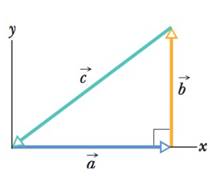
Concept explainers
For the vectors in Fig. 3-32, with a = 4, b = 3, and c = 5, what are (a) the magnitude and (b) the direction of

Figure 3-32 Problems 33 and 54.
Want to see the full answer?
Check out a sample textbook solution
Chapter 3 Solutions
Fundamentals of Physics Extended
Additional Science Textbook Solutions
Applied Physics (11th Edition)
Physics for Scientists and Engineers with Modern Physics
Essential University Physics: Volume 1 (3rd Edition)
College Physics (10th Edition)
Physics for Scientists and Engineers: A Strategic Approach with Modern Physics (4th Edition)
- Figure 1.19 shows two vectors lying in the xy-plane. Determine the signs of the x- and y-components of A, B, and A+B.arrow_forwardA pirate has buried his treasure on an island with five trees located at the points (30.0 m, 20.0 m), (60.0 m, 80.0 m), (10.0 m, 10.0 m), (40.0 m, 30.0 m), and (70.0 m, 60.0 m), all measured relative to some origin, as shown in Figure P1.69. His ships log instructs you to start at tree A and move toward tree B, but to cover only one-half the distance between A and B. Then move toward tree C, covering one-third the distance between your current location and C. Next move toward tree D, covering one-fourth the distance between where you are and D. Finally move toward tree E, covering one-fifth the distance between you and E, stop, and dig. (a) Assume you have correctly determined the order in which the pirate labeled the trees as A, B, C, D, and E as shown in the figure. What are the coordinates of the point where his treasure is buried? (b) What If? What if you do not really know the way the pirate labeled the trees? What would happen to the answer if you rearranged the order of the trees, for instance, to B (30 m, 20 m), A (60 m, 80 m), E (10 m, 10 m), C (40 m, 30 m), and D (70 m, 60 m)? State reasoning to show that the answer does not depend on the order in which the trees are labeled. Figure 1.69arrow_forwardIf A + B = 0, the corresponding components of the two vectors Aand Bmust be (a) equal, (b) positive, (c) negative, (d) of opposite sign.arrow_forward
- A delivery man starts at the post office, chives 40 km north, then 20 km west, then 60 km northeast, and finally 50 km north to stop for lunch. Use a graphical method to find his net displacement vector.arrow_forwardAt one point in space, the direction of the electric field vector Is given In the Cartesian system by the unit vector . If the magnitude of the electric field vector is E=400.0V/m , what are the scalar components , and of the electric field vector at this point? What is the direction angle of the electric field vector at this point?arrow_forwardIf two vectors have the same magnitude, do their components have to be the same?arrow_forward
- Vector A has x and y components of 8.70 cm and 15.0 cm, respectively; vector B has x and y components of 13.2 cm and 6.60 cm, respectively. If AB+3C=0, what are the components of C?arrow_forwardFor what values of a are the vectors A = 2ai − 2j + ak and B = ai + 2aj + 2k perpendicular?arrow_forwardA hiker walks from (x1, y1) = (4.00 km. 3.00 km) to (x2, y2) = (3.00 km, 6.00 km), (a) What distance has the traveled? (b) The hiker desires to return to his starting point. In what direction should he go? (Give the angle with respect to due cast.) (See Sections 3.2 and 3.3.)arrow_forward
- Vector B has x, y, and z components of 4.00, 6.00, and 3.00 units, respectively. Calculate (a) the magnitude of B and (b) the angle that B makes with each coordinate axis.arrow_forwardShow that (2arr+2brr)dt=ar2+br2+const. where r is the vector from the origin to the point (x1, x2, x3). The quantities r and r are the magnitudes of the vectors r and r, respectively, and a and b are constants.arrow_forwardYour answer is partially correct. The three vectors in the figure have magnitudes a = 3.10 m, b = 2.60 m, and c = 10.2 m and angle 9 = 35.0%. What are (a) the x component and (b) they component of a; (c) the x component and (d) they component of b; and (e) the x component and (f) the y component of ? If = pa + gỗ, what are the values of (g) p and (h) q? (a) Number (b) Number (d) Number (c) Number 2.12979 (e) Number (f) Number 3.10 (g) Number 0 -5.8504 1.991282 8.35533 i (h) Number i Units Units Units [1] Units Units m Units m Units Units m m marrow_forward
 Principles of Physics: A Calculus-Based TextPhysicsISBN:9781133104261Author:Raymond A. Serway, John W. JewettPublisher:Cengage Learning
Principles of Physics: A Calculus-Based TextPhysicsISBN:9781133104261Author:Raymond A. Serway, John W. JewettPublisher:Cengage Learning University Physics Volume 1PhysicsISBN:9781938168277Author:William Moebs, Samuel J. Ling, Jeff SannyPublisher:OpenStax - Rice University
University Physics Volume 1PhysicsISBN:9781938168277Author:William Moebs, Samuel J. Ling, Jeff SannyPublisher:OpenStax - Rice University Classical Dynamics of Particles and SystemsPhysicsISBN:9780534408961Author:Stephen T. Thornton, Jerry B. MarionPublisher:Cengage Learning
Classical Dynamics of Particles and SystemsPhysicsISBN:9780534408961Author:Stephen T. Thornton, Jerry B. MarionPublisher:Cengage Learning Physics for Scientists and Engineers with Modern ...PhysicsISBN:9781337553292Author:Raymond A. Serway, John W. JewettPublisher:Cengage Learning
Physics for Scientists and Engineers with Modern ...PhysicsISBN:9781337553292Author:Raymond A. Serway, John W. JewettPublisher:Cengage Learning College PhysicsPhysicsISBN:9781305952300Author:Raymond A. Serway, Chris VuillePublisher:Cengage Learning
College PhysicsPhysicsISBN:9781305952300Author:Raymond A. Serway, Chris VuillePublisher:Cengage Learning College PhysicsPhysicsISBN:9781285737027Author:Raymond A. Serway, Chris VuillePublisher:Cengage Learning
College PhysicsPhysicsISBN:9781285737027Author:Raymond A. Serway, Chris VuillePublisher:Cengage Learning





